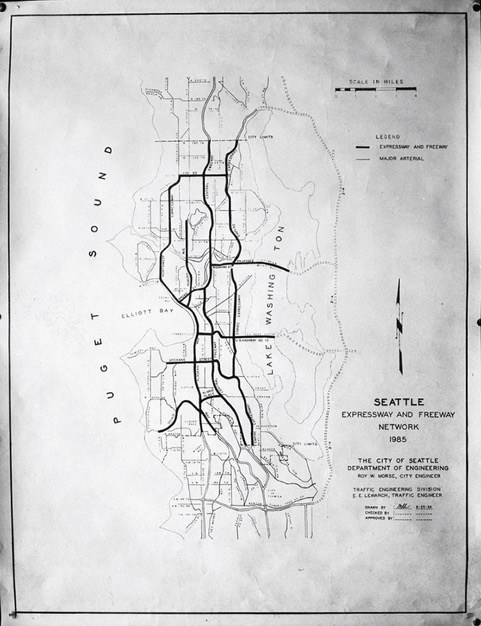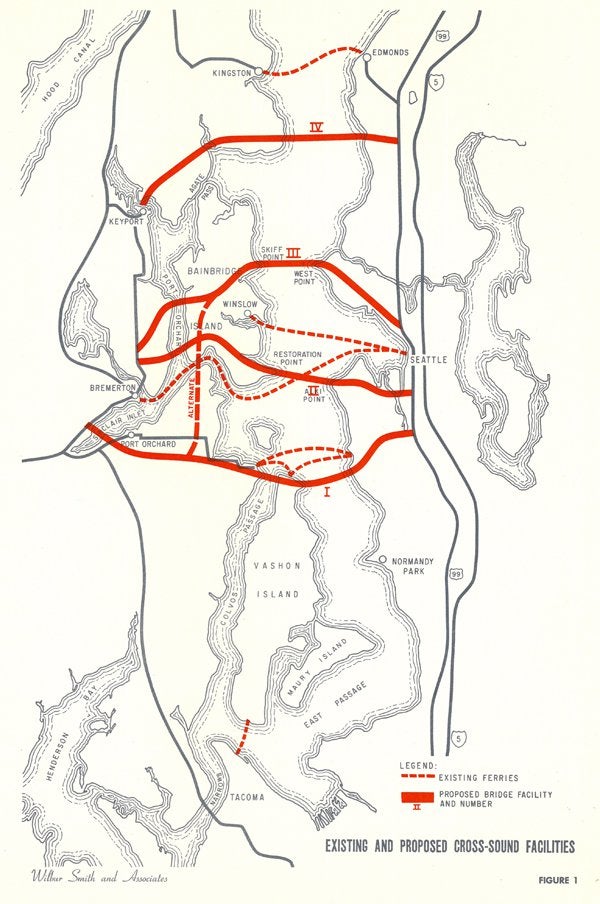Seattle has too many urban highways, but it could have had so many more if state leaders had realized all their dreams of highway expansion–including four cross-sound toll bridges. In 1965, the Washington Toll Bridge Authority floated the plan to cross Puget Sound with floating bridges connecting Seattle to four westward destinations, including Vashon Island/Southworth, Bainbridge Island (twice!), and one direct connection to the Kitsap Peninsula.
On the Seattle side, the planned cross-sound bridges would have involved ramming highways through Discovery Park and Alki Beach to feed the bridges to Bainbridge. Another crosstown highway would have plowed through Fauntleroy and Delridge to feed the bridge to Vashon and Southworth.
Our own Scott Bonjukian parodied the idea in an April Fools post back in 2016 calling for Bellevue-to-Bainbridge Bridges. “The opportunities are endless with enough concrete,” he wrote. But it was probably closer to actually happening than any of us care to admit–even as ugly and environmentally destructive as it would have been.
After all, I-5 construction displaced 40,000 Seattleites out of their homes, replacing vital urban neighborhoods with dead concrete trenches and interchanges, walling off Downtown from First Hill and Capitol Hill, and filling the newly created vacuum with noise and air pollution. People realized highways scar neighborhoods, and opposition was stiffer for future urban highway projects.

In 1970’s, I-90 made it through but just barely; 900 people turned up at Seattle City Hall mostly to protest the freeway ripping through the Central District and the International District–among the protesters were members of the Seattle Black Panther Party. The backlash won a consolation prize: a 2,000-foot lid over the freeway west of Mount Baker Ridge, a new park, and elementary school. The R.H. Thompson Expressway and the Bay Freeway, though, succumbed to the freeway revolts and were never built.

What doomed the cross-sound tollways may have been simpler: They might not have actually known how to safely build it, especially without severing the shipping routes Seattle was built on. Or maybe the demand for travel and bedroom communities in Kitsap County in the 1960s wasn’t as deafening as they imagined it to be. Whatever the reason, the cross-sound megabridges idea was dropped, and the Washington Toll Bridge Authority ceased to be in 1977, with the Washington State Department of Transportation (WSDOT) taking over responsibility for overbuilding urban highways.
History may have been different with cross-sound bridges, but today both Vashon Island and Bainbridge Island are known for their opposition to new development. Bainbridge has an apartment ban right now. And it turns out Vashon likes being remote and sparsely dotted with mansions. Maybe with bridges to Seattle these leafy islands would have taken the 40,000 people displaced by I-5 construction, replacing urban homes with suburban island ones. But one look at Mercer Island suggests an urban island oasis open to all wasn’t in the cards.
Doug Trumm is publisher of The Urbanist. An Urbanist writer since 2015, he dreams of pedestrian streets, bus lanes, and a mass-timber building spree to end our housing crisis. He graduated from the Evans School of Public Policy and Governance at the University of Washington in 2019. He lives in Seattle's Fremont neighborhood and loves to explore the city by foot and by bike.

